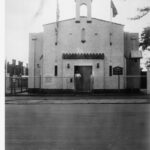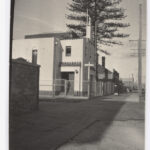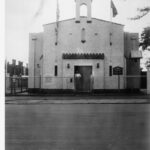The Church of Archangels Michael and Gabriel on Franklin Street was first established in 1936. The building, designed by Gordon Beaumont Smith in 1937, was consecrated in 1938. Adelaide’s Greek Orthodox community at that time numbered around 100 people. With the rapid growth of the Greek Orthodox population in Adelaide in the post-war period, the current Cathedral Church of Archangels Michael and Gabriel was rebuilt on the foundations of the original church building in 1967. The church is an important centre for Greek community life, culture and language.
Greek Migration to South Australia
Greek migration to Australia began in the nineteenth century. Most of the first Greek migrants to arrive in South Australia were single men, who worked as sailors, in food industries, retail or in the smelting industry at Port Pirie. After Greece’s military loss to Turkey in 1922, and the Great Depression in the 1930s, many Greeks, particularly from the islands migrated to Australia.
Following the Second World War and the introduction of Australia’s new post-war migration schemes and later family chain migration patterns, the Greek population in South Australia increased rapidly. Today nearly 38,000 people in South Australia identify as being of Greek ancestry, and Greek is the second most commonly spoken language other than English.
Foundations of the Greek Orthodox Church in Adelaide
The land on which the church was built was purchased in March 1936 for £540. It was blessed by the Archbishop of Australia and New Zealand, Timotheos Evengelides. Using funds raised by Greek communities throughout South Australia, the church was built at a cost of £3000.
The foundations for the Greek Orthodox Church of Archangels Michael and Gabriel were laid in 1936 by Evengelides. He was accompanied by Adelaide’s Archimandrite Germanos Heliou, as well the Anglican Dean of Adelaide, Graham Jose. The ceremony was followed by a luncheon at the South Australian Hotel, where toasts were made to the King of England, the King of Greece and the Greek Orthodox Church. Guests included prominent members of Australia’s nationwide Greek community, including the editor of the Hellenic Herald in Sydney, Alexander Grivas.
The original Church of Archangels Michael and Gabriel was designed by Gordon Beaumont Smith, a student of Walter Bagot who was known primarily for his residential housing designs. The design was described as having a ‘Mediterranean flavour’, with simple features echoing the austerity of monastic buildings found along the Greek coast. The interior, measuring 55 feet by 33 feet, was intended to seat 200 people. The vestibule and sanctuary inside were divided by an 11 foot wooden screen, which was covered with religious icons depicting Biblical scenes. The interior also featured exposed interior beams, terracotta floor tiles and leaded amber glass windows, while the exterior brick walls were stuccoed and colour washed and accented on the roof and window sills with red terracotta tiles. Alongside the church was a belfry, containing a bell from the Greek Orthodox church in Perth.
With the significant growth of the Greek Orthodox population in South Australia following the Second World War, the congregation outgrew the capacity of the church. The new church was built on the foundations of the old building in 1967, and is now heritage listed.
The Cathedral Church of Archangels Michael and Gabriel is also the See of the leader of the Autocephalous Greek Orthodox Church of America and Australia, Chrysostomos Metropolitan.
The Church and Greek Community Life
The church of Archangels Michael and Gabriel became an important centre for Greek community life in Adelaide. Church rituals, rites and celebrations allowed the Greek community to maintain links with Greek culture, language and traditions and created a sense of shared identity between groups from different regions of Greece. The church continues to be an important ecclesiastical centre for the Autocephalous Greek Orthodox Church of America and Australia, of which the church of Archangels Michael and Gabriel was one of the founding churches.








Comments
5 responses to “Church of Archangels Michael and Gabriel”
Hi Vedrana
Thank you for the write up on the Church of Archangels Michael and Gabriel located in Franklin Street Adelaide. I am from Adelaide but living in London at the moment. My grandfather (Constantine Kavooris), as well as a few families were involved in collecting funds and building this church. They were Greek people that originally resided in Asia Minor a town called Levissi (now known as Kayakoy and in Turkey). They had to flee in the 1920s and came to reside in Adelaide. I have come across an organisation in Athens, whose members were descendants of Greeks that came from Levissi. They are really interested in finding out more about this church. I was looking to get your advice on how I can access records that would list the founding members that created this church. Any advice or information you could offer would be greatly appreciated.
Hi Irene,
Unfortunately Vedrana’s not working with us any more, she did some wonderful research! If you’re researching from afar and not able to visit the archives I would suggest starting with Trove: https://trove.nla.gov.au/newspaper/search?adv=y – you might be able to find newspaper articles referencing the founding members. You can see the articles Vedrana used to inform this piece if you click on the ‘Sources’ above the comments here.
Hello Catherine and Vedrana,
I am a decendant of Anthony Malliaros from Levissi, who was involved in building this church. Thankyou for this information. I am interested in contacting Levissi descendants as I plan to exhibit recent photos of the abandoned stone village of Levissi, Turkey.
Mary Kastanos
Thanks Mary,
Unfortunately we’re not in direct contact with any descendants, but we’d love to hear how you go with your research.
HI Mary,
My family have been members of Archangels Michael and Gabriel since my grandparents and great aunts and uncles came here from Cyprus. Though we don’t have relatives from Levissi, we would love to see the images you have from there, as it directly connects to the history of this great church.
Thanks,
Kosta Zacharias